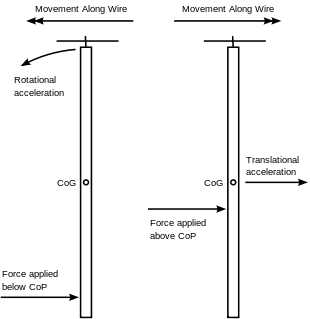Center of percussion
The center of percussion is the point on an object where a perpendicular impact will produce translational and rotational forces which perfectly cancel each other out at some given pivot point, so that the pivot will not be moving momentarily after the impulse. The same point is called the center of oscillation for the object suspended from the pivot as a pendulum.
Centers of percussion are often discussed in the context of a bat, racquet, sword or other long thin objects. The center of percussion may or may not be the "sweet spot" depending on the pivot point chosen.
Further explanation

Imagine a beam is suspended from a wire by a U-bolt so that it can move freely along the wire. A blow to the beam below the center of gravity will cause the beam to rotate around the CoG (center of gravity) and also cause the CoG to move away from the blow. If the blow falls above the CP (center of percussion) the movement of the CoG will cause the U-bolt to move away from the blow since the effect of the translational acceleration will outweigh the effect of the rotational acceleration. If the blow falls below the CP the opposite will occur, rotational acceleration will outweigh translational acceleration and the U-bolt will move towards the blow. Only if the blow falls exactly on the CP will the two cancel out to produce no net movement of the U-bolt.
Calculating the center of percussion
For a free, rigid beam, a force F applied at right angle at a distance b from the center of gravity (CoG) will result in the CoG moving at a velocity V according to the relation:[1]
where M is the mass of the beam. Similarly the torque exerted will be as per the relation:
where I is the moment of inertia around the CoG and  is the angular velocity.
is the angular velocity.
For any point P on the opposite side of the CoG from the point of impact, the velocity of point P is
where A is the distance of P from the CoG. Hence:
The velocity v is then given by:
The axis of rotation is situated where  and the corresponding center of percussion is at distance b from the CoG, with
and the corresponding center of percussion is at distance b from the CoG, with
This is also the center of oscillation of a physical pendulum of the same mass M, hung at the pivot point. (The center of oscillation is the position of the mass of a simple pendulum that has the same period as the physical pendulum.)[2]
Center of percussion of a uniform beam
For the special case of a free beam of uniform density of length L the moment of inertia around the CoG is:
 (see moment of inertia for proof)
(see moment of inertia for proof)
Hence:
Relation to the sweet spot
The sweet spot on a baseball bat is generally defined as the point at which the impact feels best to the batter (it is also occasionally defined as the point at which the maximum velocity is imparted to the ball, but this may not be the same point).
Although it has long been believed the center of percussion and the sweet spot are the same, recent practical observations have indicated that the point many batters feel is "sweetest" corresponds to a pivot point in the arm, beyond the handle of the bat.
Application to swordmaking
The center of percussion of a sword is the point on the blade where cutting produces the least hand shock. It is also the division between the weak and middle sections of the blade.
Like the center of balance of a sword, the center of percussion can be moved by employing a heavier pommel or changing the mass distribution of the blade.[3]
One of the nodes of the fundamental flexural vibration (the node closest to the tip) is also often (mistakenly) referred to as the center of percussion, which is why it has been suggested to use the terms center of oscillation and vibrational node to denote the respective points without ambiguity.[4] The significance of the vibrations about this mode have been contested as having little relevance to sword physics.[3]
So-called “blade harmonics” are a commonly misunderstood concept. The common belief is that a sword must be “harmonically balanced” in order to cut properly, because the vibrations would otherwise interrupt the line and power of the cut. As explained above, this proposition is false: the vibrations caused by a sword cut are almost unnoticeable except as a mild stinging to the hands even in blades that lack this quality. It has also been demonstrated that the object the sword cuts through serves to further reduce the intensity of any vibration, making it even less noticeable.
Many experts speculate that harmonic balance is merely a byproduct of proper construction and balancing, rather than an intentional quality added to weapons. Unfortunately, some sword vendors advertise "secret techniques" of harmonic balancing in an attempt to "prove" the superiority of their products. This only serves to amplify the false impressions of the value of harmonic balance by seeming to lend them legitimacy.[3]
See also
References
- ↑ Rod Cross (2004). "Center of percussion of hand-held implements" (PDF). American Journal of Physics 72 (5): 622–630. Bibcode:2004AmJPh..72..622C. doi:10.1119/1.1634965.
- ↑ Daniel A. Russell (June 16, 2005). "What is the COP and does it matter?". Physics and Acoustics of Baseball & Softball Bats. Pennsylvania State University. Retrieved May 24, 2012.
- ↑ 3.0 3.1 3.2 George Turner (1999). "Sword Motions and Impacts: An Investigation and Analysis". Association for Renaissance Martial Arts. Retrieved May 24, 2012.
- ↑ Geißler, Robert (2014). "Concerning the Dynamics of Swords". HROARR. Retrieved January 18, 2015.






